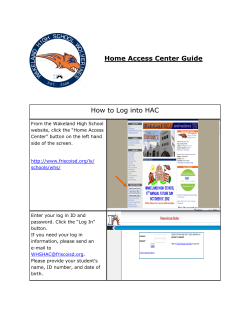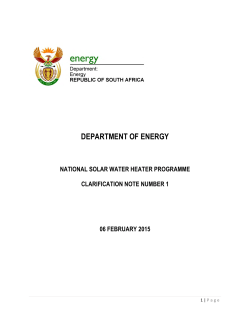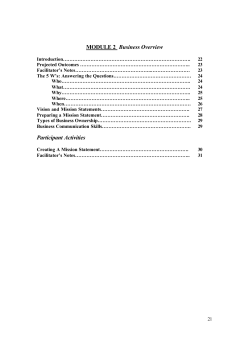
Getting involved in planning applications
Getting involved in planning applications As a member of your local community, you have local knowledge that makes your views important. By understanding the planning system and how to respond to planning applications, you may be able to use this local knowledge to influence development at an early stage, perhaps preventing a harmful development or enhancing a proposal’s value to wildlife. This PDF will give you some tips. Getting involved It is important to remember that the planning process encourages people with an interest in a proposed development to comment on applications. You can help to protect and enhance your local environment by influencing planning decisions in your area. Finding out about planning applications To build on land, a developer must first submit a planning application to the DoE Planning, unless the development is small, such as a shed (known as ‘permitted developments’ that do not require planning permission). There are a number of ways to find out about the planning applications in your area: notices posted at the site of the proposed development advertisements in the local paper neighbours or adjacent landowners will be notified and planning consultees will be informed files at your local divisional planning office the DoE Planning website (www.planningni.gov.uk/) Applications are listed by Council area according to the schedules for discussion at Council planning committees. Once a planning application has been announced, interested parties have to submit their responses before a deadline that will be a minimum of 14 days. Local Planning Pack: step up for wildlife near you Page 1 Different types of planning application A planning application can be ‘full’ or ‘outline’. Full planning applications include every detail needed for the DoE Planning to decide if the proposal can go ahead. Outline applications need contain only enough information for DoE Planning to decide whether the principle and broad type of development is acceptable although Doe Planning may request further details. If an outline application is approved, then the applicant must submit a ‘reserved matters’ application that addresses all the outstanding details, such as visual appearance, servicing and landscaping. This must also be approved before development can start. The differences between these types of planning application can affect the scope of your comments. For example, if you missed an opportunity to comment on an outline application for a development that affects a wildlife site and it was approved, the scope of any objections to the follow-up ‘reserved matters’ application can only relate to the detailed design and layout of the development, not the principle of it. For more information see our PDF The planning system in Northern Ireland. Why might you take action? You may want to object to a proposed development as it will impact on the countryside and wildlife in your area. An important first step is to assess the wildlife value of the site (see our PDF Assessing the value of your wildlife site). You may also feel that the development could be made more sympathetic to the local environment, enhancing opportunities for biodiversity. It is important that your concerns have some weight to them, as the planning officers will only be influenced only by facts. Your involvement in the planning system may not be limited to objecting to potentially harmful planning applications. In some circumstances you might want to support an application, as it will be beneficial to biodiversity and be built with consideration for local wildlife. Early involvement It is very important to get involved at a very early stage in the planning process. Once the objection period lapses there is little, or no, opportunity for influencing planning decisions. Local Planning Pack: step up for wildlife near you Page 2 However, because many applications are subject to delays it is worth contacting the planning officer dealing with the case if you are unsure of deadlines. Commenting on planning applications You must send written comments to the relevant Planning Division that will be determining the application. When submitting a written comment on an application, whether to object or support it, you should remember the following: all planning applications have a name and a specific reference number that you should clearly refer to clearly state why you are objecting or supporting the development. Include the wording ‘I/We object’ or ‘I/We support’ in the text you must act within a set timescale, responding before the consultation deadline (if you don’t have a letter from the Planning Service with this on, you can find it out by ringing DoE Planning) state your name, address and other contact details be concise and polite! Keep your letter short, a maximum of two sides – put any detailed comments in a supporting document if necessary include information about important habitats and wildlife at the site that you have found (see our PDF How important is your wildlife site) if there has already been a refusal for a similar application at the site, refer to the ‘reasons for refusal’ in the previous decision notice it may be useful when making a submission with a nature conservation element to send copies of letters of objection to NIEA and other environmental organizations planners will also be particularly keen to hear your views on non-wildlife impacts of development such as traffic congestion in the local area, overburdening of parking spaces and public transport, demands for water from local rivers or resulting pollution in rivers and streams. If you want your concerns to be taken seriously don’t include hearsay or information you are unsure about don’t include unsubstantiated criticism of DoE Planning or the applicant, eg personal circumstances or character don’t exaggerate your claims don’t include information unrelated to the development or its impacts. Local Planning Pack: step up for wildlife near you Page 3 Some additional things to consider when responding to a planning application DoE Planning often imposes planning conditions with planning permission agreements. Planners may welcome suggestions of conditions from interested parties, particularly if they help to make a proposal acceptable. It can be helpful to specify what conditions you think are needed in your letter to the planners. Consider for example: Do the proposals retain (as far as possible) any existing wildlife features on the site like ponds and hedgerows? Do the proposals use native plants and trees in any landscaping designs? Could the development be redesigned, phased or laid out differently to reduce its effects on wildlife? Care needs to be taken in drawing them up and to be useful suggested conditions must be: relevant to planning matters and to the permission clear and precise enforceable reasonable Documents that may help you When making detailed comments about a planning application you may want to refer to some of the following documents: Area Plans The Area Plans are a collection of documents and maps, and their function is to plan changes to local council areas over the next 10–15 years. Area Plans can be viewed on the DoE Planning website (www.planningni.gov.uk). You can use this information to compare how a planning application conforms to guidelines set out in the Area Plans. For example, if an area of open space has been zoned for housing, there is limited scope for objecting to a housing development for that site. Alternatively, if an area is identified in the plan as a Site of Local Nature Conservation Importance (SLNCI) it offers support for objections to housing or industrial development on that site. Local Planning Pack: step up for wildlife near you Page 4 Planning Policy Statements (PPSs) PPSs contain policies on land use and other planning matters in Northern Ireland and they can also be found on the DoE Planning website (www.planningni.gov.uk). PPS2 contains nature conservation policies (see our PDF The planning system in Northern Ireland). The Environmental Impact Assessment (EIA) For applications that are likely to significantly affect the environment, an EIA must be carried out. The purpose of an EIA is to assess the extent of the development and try to reduce the negative impacts that it will have. Where one must be carried out, a report on the EIA (usually referred to as the Environmental Statement (ES)) is submitted as part of the planning application and you should be able to read it at the local Divisional Planning Office. Copies of parts of the ES can often be requested for a small fee, but if you are serious about objecting to a planning application it is better to own a complete copy so you have easy access to all the detailed information. This may be expensive, so consider pooling resources with other campaigning organizations. You can include comments about the EIA and the ES in your objection letter if you feel it does not comprehensively address all the development’s likely impacts on the environment. District Council planning committee meetings Local councils have planning committees for considering planning applications. DoE Planning consults with Councils at monthly meetings at which councils can make recommendations to DoE Planning for approval or refusal. You can ask your local councillor to represent your views at that meeting. What happens to an application once your comments have been submitted? Once your objection has been submitted it will be considered together with others in the decision-making process. Letters of objection are normally acknowledged within five working days of their receipt. Objectors should be kept informed about changes to an application or additional information that has been provided by the developers. However, just to be sure, it is worthwhile keeping in touch with the planning office for up to date information. The final decision may be made many months after the initial application. Local Planning Pack: step up for wildlife near you Page 5 With each decision, DoE Planning issues a decision notice. Where the decision is to grant permission, the decision notice lists any planning conditions which may be attached to the permission. The notice may also include informatives, which are recommendations to the applicant, while conditions are mandatory. If the permission is refused, the notice will list reasons for refusal. The decision notice is not automatically sent out to every objector, but can be requested from DoE Planning. Alternatively you can view all related documents to an application, including the decision notice on the DoE website (www.planningni.gov.uk). This currently applies to applications post 2010 though the intention of DoE is that all previous applications will be scanned to the website over time. Appeals against a decision If a planning application is refused, applicants can take their application to appeal. In Northern Ireland, third parties (eg the general public) cannot appeal against a planning decision. However, if you have made an objection to a planning application, which is then refused and the developer appeals, you have the right to make further representations to this appeal, and if an inquiry is held, to appear at the inquiry to make your case. DoE Planning should get in contact with you with the details of what you have to do when the appeal is lodged. For more information about how the appeals process works refer to the PAC website (www.pacni.gov.uk). Complaining to the Divisional Planning Office If you have a complaint about the way a planning application was dealt with (rather than the nature of the proposal) you can report it to the Divisional Planning Office. Full details of the complaints procedure are available on the DoE planning website (www.planningni.gov.uk). Local Planning Pack: step up for wildlife near you Page 6
© Copyright 2025





















